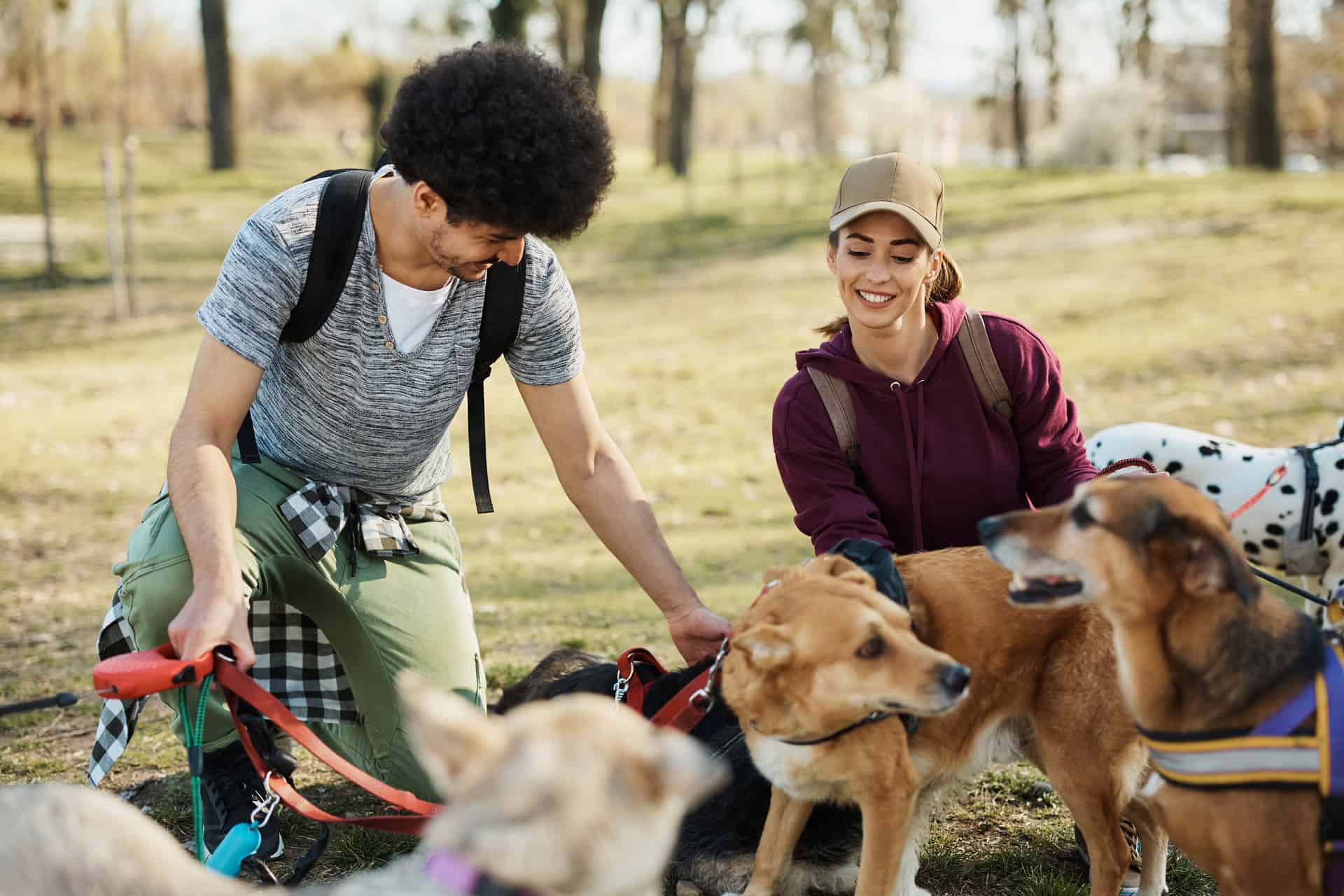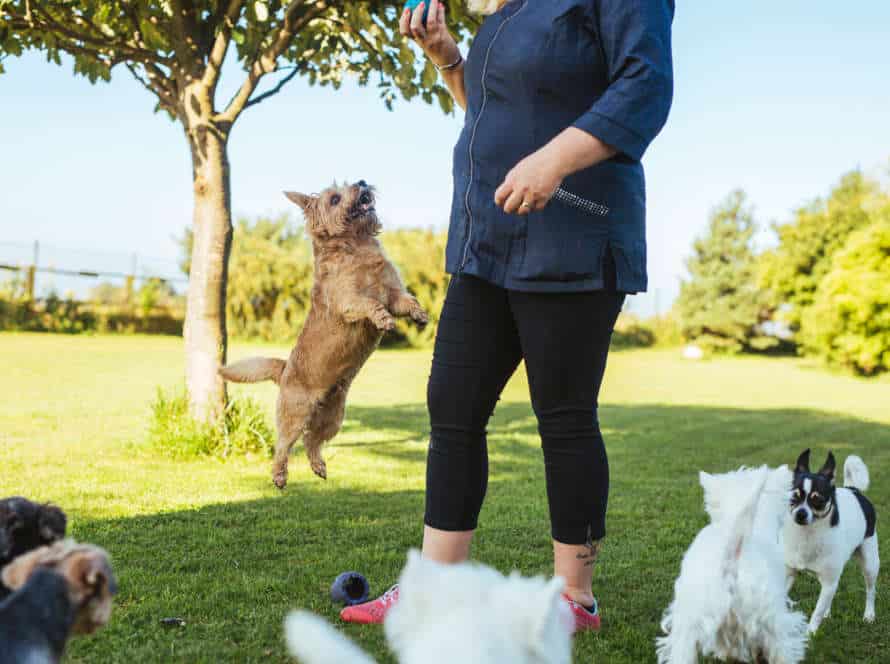Training Tips for Stubborn Dogs
Training a determined pup can be hard. But, with the correct tips, you can teach your pup obedience and good conduct. A few tips for stubborn dogs:
- Be patient and stay consistent. Stubborn dogs need lots of patience and persistence. You must stay calm and stay the same with your training.
- Use positive reinforcements. Good rewards, such as treats, compliments, and toys, can motivate your pup to obey you.
- Keep training brief and focused. Stubborn dogs may lose interest quickly, so keep sessions short and on-topic. Repeat and stick to the same commands for reinforcement.
- Use an authoritative voice. Using a firm and clear voice shows your pup that you are in charge.
- Vary training methods. Stubborn dogs may need different techniques, like clicker training, leash training, or socialization training, to learn and adopt good behaviors.
Remember: with patience, persistence, and positive reinforcement, you can train even the most stubborn of pooches!
Understanding Your Stubborn Dog
Training stubborn dogs can be hard! It’s important for pet owners to get to know their pup’s behaviour. Understand the body language, vocalizations and environment. This will help pet owners to make sense of their dog’s behaviour. Understanding motivations and triggers will enable owners to train and coach their stubborn pup better.
Behavioral issues that contribute to stubbornness
Stubbornness in dogs is a common problem. This can be due to various behavior issues. It’s vital to identify these, to train your obstinate pup.
Fear and anxiety can cause dogs to be stubborn. If they’re afraid of certain people or situations, they won’t listen.
Insufficient socializing can lead to stubbornness. Dogs that haven’t been socialized enough may not obey their owners.
Dominance may also be an issue. Your dog may be trying to be the leader.
Sometimes there’s just no motivation. Dogs may be stubborn because they don’t have a reason to obey.
Recognizing what’s causing the issue is the first step. Then you can use consistency, positive reinforcement and patience to train your pup.
Training methods that work best for stubborn dogs
It’s important to know that a pup’s stubbornness may have various reasons, like their breed, age, or background. But, don’t worry! There are training solutions to manage this behaviour. Here are some tips that work best:
- Use treats and praise instead of scolding.
- Make the sessions short and fun, with breaks to avoid frustration.
- Be consistent and patient with the training. Don’t give up easily!
- Adjust the techniques to fit your pup’s personality and learning style.
Remember, persistence and a positive attitude are the keys to obedience and a strong bond with your furry friend – no matter how stubborn they are!
The importance of patience and consistency in training
Patience and consistency are essential when training a stubborn pup. Not only can consistent training help your dog comprehend what you want from them, but it can also enhance the connection between you and your furry friend.
Here’s how these qualities can help train your stubborn dog:
- Patience: Training a stubborn pup requires a lot of patience from you. Dogs can sense when we get frustrated or angry, which makes it tougher for them to learn. So, it’s essential to stay relaxed and patient throughout the process, even when it appears like your pup isn’t making much progress.
- Consistency: Consistency is vital when it comes to training any dog, particularly a stubborn one. This means forming a regular routine for training and adhering to it. Also, utilize the same commands and rewards each time so that your pup knows what to anticipate.
Pro tip: Always reward good behavior with positive reinforcements and never punish your pup for not understanding right away.
Techniques for Training Stubborn Dogs
Taming a stubborn dog? Not an easy job. But, with the right tricks and methods, you and your pup can have a great experience. These strategies are confirmed to be useful with most stubborn dogs. They’ll help you bond and trust each other. Let’s find out how to use them to your advantage!
Positive Reinforcement Training
Positive reinforcement training is a great way to train your pup! You reward your canine’s good behavior with treats, praise, or affection. This technique works well with stubborn doggos since it encourages desirable actions and not punishing the bad ones. Here are some tips to get you started:
- Begin with simple commands, then move on to more complex ones.
- Give your pet yummy treats like chicken or cheese to motivate them.
- Make sure to remain consistent with rewards and commands.
- Training sessions should be short and often, such as 10-15 minutes per day.
- Besides treats, use verbal praise and physical affection (like belly rubs) to reward good behavior.
Positive reinforcement is an effective way to create a strong bond between you and your pup! It nurtures trust and mutual respect.
Clicker Training
Clicker training is a positive reinforcement method used to teach dogs. It makes use of a clicker and treats to reward good behavior. If your dog is tough to train, here are some tips:
- Start with commands such as “sit,” “stay,” and “come.” Click and give a treat each time they do it right.
- Be consistent with clicker and treat schedule. Slowly make the commands harder.
- Don’t punish bad behavior. Instead, ignore or change the behavior and reward the good.
- Use clicker training in daily activities such as meals, walks and play.
- Be patient and consistent. Stubborn dogs may take longer, but with enough practice and positive reinforcement, they’ll learn it.
Leash Training
Leash training is a must for keeping your pup well-behaved. But it can be tough with stubborn dogs! Here are some successful tips:
- Patience: Consistency is key. Takes time for them to change their habits, so be consistent and patient.
- Rewards and positive reinforcement: Use yummy treats to encourage your dog to obey. Positive reinforcement leads to better behavior.
- Right leash: Choose the ideal leash for your pup. Try different lengths and materials to find what’s best.
- Distractions: Use toys or treats to distract your dog and stop them from pulling or running away.
- Vocal commands: Say “stop” or “sit” while teaching.
These tips will make leash training enjoyable for you and your pup.
Pro tip: Show lots of love and affection during training.
Common Training Challenges with Stubborn Dogs
Training a stubborn pup can be a tough and lengthy process. It needs plenty of patience and regularity. When owners find their pooch won’t even learn the simplest commands, they may become frustrated. But, there are some tips to help owners train their difficult dog. Here are a few of the most common difficulties and ways to defeat them:
Pulling on the Leash
Pulling on the leash can be a challenge when training stubborn dogs. Here are some tips to help:
- Use front-clip harness or head halter to stop it.
- As soon as your dog pulls, stop and wait till they relax.
- Praise or give treats when they walk calmly by your side.
- Start in a calm, low-distraction environment and increase distractions gradually.
- Be consistent; all household members should use same techniques.
Patience and practice will help you train your stubborn pup to walk on a leash.
Refusing to Come When Called
Training stubborn dogs can be tricky. But it’s not impossible! Here are some tips to help:
- Use treats or praise when they come. This will give them the message to do it again.
- Don’t use their name for punishment. It could make them dislike the command.
- Start in a quiet place with no distractions. Then move to busier places.
- Keep the sessions short and fun. Always end on a good note.
With patience and consistency, even stubborn dogs can learn to come when called.
Barking Excessively
Excessive barking is a top challenge for dog owners, especially those with stubborn pooches. Here’s how to tackle it:
- Find out why they bark too much: Out of boredom, anxiety or just protecting their turf? Knowing the cause can help reduce barking.
- Praise and reward them when they’re quiet: This will reinforce good behavior and prompt them to stay calm.
- Train them with commands: Teach your pup to stop barking when you say “quiet“. Reward them when they do what you want.
- Exercise them: Enough exercise can reduce anxiety and boredom – two common triggers for excessive barking.
- Get help if needed: If the barking won’t quit, get the help of an expert trainer or behaviorist.
Remember: Training a stubborn dog needs patience, consistency and positive reinforcement. Pro tip: Use treats to motivate your pup during training.
Addressing Behavioral Issues in Stubborn Dogs
Training a stubborn pup can be tricky! You need patience, consistency, and dedication. To be successful, you must understand the source of any bad behavior. Let’s discuss how to address behavioral issues in stubborn dogs.
Separation Anxiety
Separation anxiety is a common problem in puppies. But, it’s especially tough with stubborn canines. Here are four techniques to try:
- Introduce ‘aloneness’ in short stages, with rewards when you return.
- Exercise can make a difference for active pooches! A walk or playtime before leaving.
- Make solo time a positive experience. Give treats or toys, only when your dog is alone.
- Professional help can be invaluable. Get advice from a professional dog trainer or behaviourist.
Be patient and consistent for successful results with determined doggies!
Aggression Issues
Dogs can be aggressive for a range of reasons, such as fear, protection, dominance or stress. To tackle this in strong-willed dogs, it takes patience, consistency, and positive reinforcement.
Here are some tips:
- Socialize your pup at an early age. Let them meet different people, animals and places.
- Teach basic commands using positive reinforcement. Like ‘sit’, ‘stay’ and ‘come’.
- Desensitize and counter-condition them to things that cause aggression.
- Steer clear of punishment-based training.
- If needed, seek help from a dog behaviourist.
Be patient and remember to reward success.
Pro Tip: If your dog bites or attacks, take extra caution and get help from a pro.
Fear-Based Behaviors
Fear-based behaviors are a common cause of stubbornness in dogs. These come from anxiety, stress, or trauma. Dogs can become resistant to training and disobey commands. To address this, patience, understanding and the right training techniques are needed. Here are some tips:
- Create a positive association – Use treats, toys and praise to encourage positive behavior.
- Keep sessions short – Keep them brief and frequent, so your dog won’t become overwhelmed.
- Desensitization and counter-conditioning – Gradually introduce your dog to stimuli which trigger fearful behaviors, paired with positive reinforcement.
Addressing fear-based behaviors requires dedication and patience. Every pup is unique and needs different techniques. Persist and find the one that works for them. Professional help may be needed.
Hiring a Professional Dog Trainer
Fed up with your pup’s stubbornness? Consider hiring a professional dog trainer. It can give you the insight you need to understand your pup’s behavior and help them reach the desired behavior. In this article, we’ll discuss the perks of hiring a pro and the techniques they use for training pups.
Researching and selecting a reputable dog trainer
Finding a reliable dog trainer to handle a stubborn pup can be tricky. Here are some tips to assist you in locating the perfect trainer for your four-legged friend:
- Ask your vet, pet store, or other pet owners for referrals.
- Do your research online. Read reviews and check the trainer’s qualifications and experience.
- Check if the trainer uses positive reinforcement techniques like treats and compliments, instead of punishment-based approaches.
- Schedule a consultation with the trainer before signing up for the training. Assess their techniques, facility, and communication skills.
- Ensure the trainer is certified by an accredited organization, e.g. APDT (Association of Professional Dog Trainers).
- A trustworthy trainer should be transparent, patient, and understanding of your dog’s needs. They should also be able to adjust their training to your pooch’s personality and learning style.
Pro tip: Ask for references and talk to the trainer’s past clients to get an idea of their proficiency and professionalism.
Benefits of hiring a professional dog trainer
Hiring a pro doggy trainer can have heaps of advantages for both you and your furry mate. Here are some of the perks:
- A tailored plan: A pro will develop a training plan that fits your pup’s needs and your aims.
- Swift learning: A trainer will use successful teaching techniques to swiftly teach your pup new commands and behavior.
- Troubleshooting: A trainer can give assistance to address any misbehaviour that your pooch may have, like chewing, barking, or aggression.
- Long-term success: A trainer can give you the skills and tools to keep training your pup even when their services have completed.
Training stubborn canines can be a difficult task, but a professional dog trainer can provide specialist advice and support to help your pup overcome their obstinacy and become a behaved companion.
Questions to ask before hiring a dog trainer
Getting the ideal dog trainer is key when teaching your four-legged friend. Before hiring, ask them these queries:
- What’s your training philosophy? It’s essential to make sure their methods and beliefs are in line with yours.
- What’s their experience? Ask about qualifications, experience, and a record of successful training.
- Can I watch previous training sessions? See how they communicate, use methods, and handle tricky cases.
- What’s their availability? Ensure they have the time to meet your needs and wants.
Get a trainer who is patient, seasoned, and qualified to help train your pup. Tip – Request references and reviews from former customers for a more informed choice.
Frequently Asked Questions
1. Why is my dog so stubborn during training?
A: Some dogs are naturally independent and require more patience and persistence during training. It’s important to find methods that work best for your dog and to consistently reinforce positive behaviors.
2. Can I use punishment or physical force to correct my stubborn dog’s behavior?
A: No, punishment or physical force can damage the bond between you and your dog, and can often worsen behavior problems. Positive reinforcement and rewards-based training methods are more effective and build trust and respect.
3. How long does it take to train a stubborn dog?
A: Training times vary for each individual dog and depend on factors such as age, breed, and temperament. Consistency, patience, and persistence are key to successful training, and it may take several weeks or months to see progress.
4. What are some effective training tips for stubborn dogs?
A: Some effective training tips for stubborn dogs include using positive reinforcement, consistency, patience, breaking down skills into smaller steps, and finding what motivates your dog (food, toys, praise, etc.). It’s also important to be calm, assertive, and consistent with commands.
5. Should I hire a professional dog trainer for my stubborn dog?
A: If you’re struggling with training and behavior issues, it may be helpful to seek guidance from a professional dog trainer. Look for a trainer who uses positive reinforcement methods and has experience with stubborn breeds.
6. What should I do if my stubborn dog is still not responding to training?
A: If your dog is not responding to training, it may be helpful to reassess your training methods and seek guidance from a professional trainer. It’s also important to rule out any underlying medical or behavioral issues that could be contributing to the problem.







